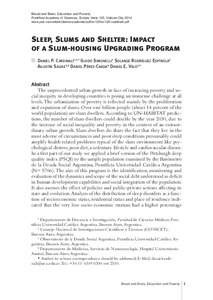Please use this identifier to cite or link to this item:
https://repositorio.uca.edu.ar/handle/123456789/1634| Título: | Sleep, slums and shelter : impact of a slum-housing upgrading program | Autor: | Cardinali, Daniel Pedro Simonelli, Guido Rodríguez Espínola, Solange Sylvia Salvia, Agustín Pérez Chada, Daniel Vigo, Daniel Eduardo |
Palabras clave: | MEDICINA; SUEÑO; POBREZA; CALIDAD DE VIDA; SALUD; TRASTORNOS DEL SUEÑO | Fecha de publicación: | 2014 | Editorial: | Pontifical Academy of Sciences | Cita: | Cardinali, D. P., et al. Sleep, slums and shelter: impact of a slum-housing upgrading program [en línea]. En: Battro, A. M., Potrykus, M., Sánchez-Sorondo, M. (eds.). Bread and brain, education and poverty. Pontifical Academy of Sciences, Scripta Varia 125. Ciudad del Vaticano : Libreria Editrice Vaticana, 2014. Disponible en: https://repositorio.uca.edu.ar/handle/123456789/1634 | Resumen: | Abstract: The unprecedented urban growth in face of increasing poverty and social inequity in developing countries is posing an immense challenge at all levels. The urbanization of poverty is reflected mainly by the proliferation and expansion of slums. Over one billion people (about 14 percent of the world population) are slum dwellers. According to UN-HABITAT predictions, the number of slum dwellers could double by the year 2030, due to the increase of social inequality and poverty in the context of an extraordinary urban growth. Slum dwellers do share the fact that they live in the most adverse of circumstances and poor sleep conditions presumably could amplify health related problems typical of the slum environment like psychological distress, poor diet, a sedentary lifestyle and cardiovascular disease. In a first part of our study we applied a brief version of the Pittsburgh sleep quality index (PSQI) to the sample population examined by the Barómetro de la Deuda Social Argentina, Pontificia Universidad Católica Argentina (N= 5766). The aim of this program is the identification, monitoring and evaluation of the dynamics and scope of the social debt understood as deficit in human development capabilities and social integration of the population. It also assesses the effect of policies and public-private actions affecting its state and evolution. Analysis of the distribution of sleep disorders as a function of socioeconomic status, residential status and place of residence indicated that the very low socio-economic stratum had a higher percentage of subjects with poor quality of sleep and daytime sleepiness (p < 0.001). The residence in slums was associated with a higher percentage of subjects with poor sleep quality and obesity (p < 0.001). In the second part of our study we evaluated the impact of a housing transition on sleep quality and quality of life in slum dwellers, participating in a slum-housing upgrading program in 5 slums located in Buenos Aires’ Metropolitan Area. A total of 150 slum dwellers benefited by a housing program of a non-profit organization (“TECHO”) moving from their very low quality house to a basic prefabricated 18 m2 modular house, This was an observational before-andafter study with a convergent-parallel mixed method design. The PSQI and WHO quality of life (QOL) brief scales were administered before and after housing upgrading. Semi-structured interviews were used to expand and nuance quantitative data obtained from a poorly educated sample. Results showed that sleep quality significantly increased after the housing program (p < 0.001). Overall QOL and physical health domain, psychological wellbeing domain and environmental domain of QOL were also improved. Therefore a minimal improvement of basic housing can significantly increase sleep quality and quality of life among slum dwellers. | URI: | https://repositorio.uca.edu.ar/handle/123456789/1634 | ISBN: | 978-88-7761-105-5 | Disciplina: | MEDICINA | Derechos: | Acceso Abierto | Fuente: | Battro, A. M., Potrykus, M., Sánchez-Sorondo, M. (eds.). Bread and brain, education and poverty. Pontifical Academy of Sciences, Scripta Varia 125. Ciudad del Vaticano : Libreria Editrice Vaticana, 2014. ISBN 978-88-7761-105-5 |
| Appears in Collections: | Artículos |
Files in This Item:
| File | Description | Size | Format | |
|---|---|---|---|---|
| sleep-slums-shelter-impact.pdf | 427,92 kB | Adobe PDF |  View/Open |
Page view(s)
370
checked on Apr 30, 2024
Download(s)
140
checked on Apr 30, 2024
Google ScholarTM
Check
Altmetric
This item is licensed under a Creative Commons License

